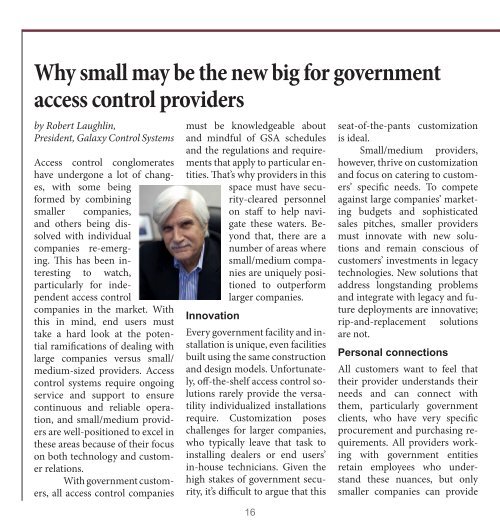Government Security News
Create successful ePaper yourself
Turn your PDF publications into a flip-book with our unique Google optimized e-Paper software.
Why small may be the new big for government<br />
access control providers<br />
by Robert Laughlin,<br />
President, Galaxy Control Systems<br />
Access control conglomerates<br />
have undergone a lot of changes,<br />
with some being<br />
formed by combining<br />
smaller companies,<br />
and others being dissolved<br />
with individual<br />
companies re-emerging.<br />
This has been interesting<br />
to watch,<br />
particularly for independent<br />
access control<br />
companies in the market. With<br />
this in mind, end users must<br />
take a hard look at the potential<br />
ramifications of dealing with<br />
large companies versus small/<br />
medium-sized providers. Access<br />
control systems require ongoing<br />
service and support to ensure<br />
continuous and reliable operation,<br />
and small/medium providers<br />
are well-positioned to excel in<br />
these areas because of their focus<br />
on both technology and customer<br />
relations.<br />
With government customers,<br />
all access control companies<br />
must be knowledgeable about<br />
and mindful of GSA schedules<br />
and the regulations and requirements<br />
that apply to particular entities.<br />
That’s why providers in this<br />
space must have security-cleared<br />
personnel<br />
on staff to help navigate<br />
these waters. Beyond<br />
that, there are a<br />
number of areas where<br />
small/medium companies<br />
are uniquely positioned<br />
to outperform<br />
larger companies.<br />
Innovation<br />
Every government facility and installation<br />
is unique, even facilities<br />
built using the same construction<br />
and design models. Unfortunately,<br />
off-the-shelf access control solutions<br />
rarely provide the versatility<br />
individualized installations<br />
require. Customization poses<br />
challenges for larger companies,<br />
who typically leave that task to<br />
installing dealers or end users’<br />
in-house technicians. Given the<br />
high stakes of government security,<br />
it’s difficult to argue that this<br />
16<br />
seat-of-the-pants customization<br />
is ideal.<br />
Small/medium providers,<br />
however, thrive on customization<br />
and focus on catering to customers’<br />
specific needs. To compete<br />
against large companies’ marketing<br />
budgets and sophisticated<br />
sales pitches, smaller providers<br />
must innovate with new solutions<br />
and remain conscious of<br />
customers’ investments in legacy<br />
technologies. New solutions that<br />
address longstanding problems<br />
and integrate with legacy and future<br />
deployments are innovative;<br />
rip-and-replacement solutions<br />
are not.<br />
Personal connections<br />
All customers want to feel that<br />
their provider understands their<br />
needs and can connect with<br />
them, particularly government<br />
clients, who have very specific<br />
procurement and purchasing requirements.<br />
All providers working<br />
with government entities<br />
retain employees who understand<br />
these nuances, but only<br />
smaller companies can provide







